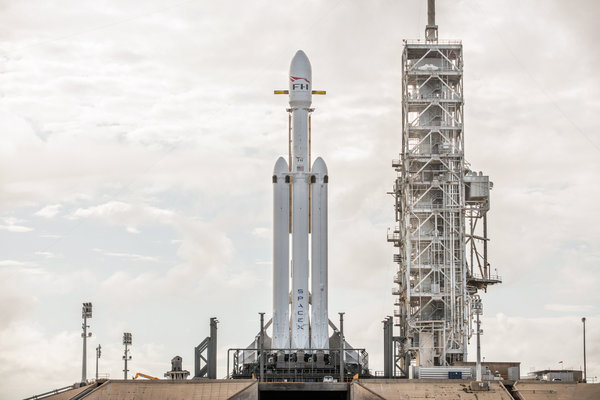SpaceX’s Big Rocket, the Falcon Heavy, Finally Reaches the Launchpad

On July 16, 1969, a towering Saturn 5 rocket sat on Pad 39A at NASA’s Kennedy Space Center in Florida. At 9:32 a.m., the five enormous F-1 engines of its first stage ignited, expelling orange flame, dark smoke and 7.5 million pounds of thrust to lift the three astronauts of Apollo 11 into space. Buzz Aldrin and Neil Armstrong set foot on the moon four days later.
Today, at that same launchpad, technicians working for SpaceX, Elon Musk’s upstart rocket company, are preparing for the maiden flight of what is by most measures the world’s most powerful rocket since the Saturn 5. The Falcon Heavy will be able to carry more than 140,000 pounds to low-Earth orbit, or more than twice as much as current competing rockets.
Aboard the demonstration flight, which may take off in the weeks ahead, will be a whimsical, cross-promotional payload for Mr. Musk — a cherry red Roadster built by his other business, the electric carmaker Tesla. The car would travel around the sun in endless ellipses that extended as far out as Mars’ orbit.
Some space advocates think Falcon Heavy could offer a quicker, cheaper path for NASA to send astronauts back to the moon. For SpaceX in the near term, the mega-rocket could help the company compete in new markets like the launching of large spy satellites for the United States government.
If successful, “it continues SpaceX’s very impressive run of achieving launch milestones that have been viewed as very difficult,” said Carissa Christensen, chief executive of Bryce Space and Technology, a consulting firm that follows the space industry.
Turned out it was rocket science
SpaceX successfully launched 18 of its workhorse Falcon 9 rockets last year, a remarkable recovery from a launchpad mishap in September 2016 that destroyed a rocket and the $200 million satellite on top. After years of falling short of optimistic predictions, SpaceX seemed to fall into a consistent, accident-free flow of sending payloads to orbit.
For 14 of the launches, SpaceX landed the boosters, to be reused for future flights.
The Heavy — described by SpaceX as far back as 2005 — is essentially a Falcon 9 with two additional Falcon 9 boosters attached to the sides. That triples the horsepower of the rocket at liftoff.